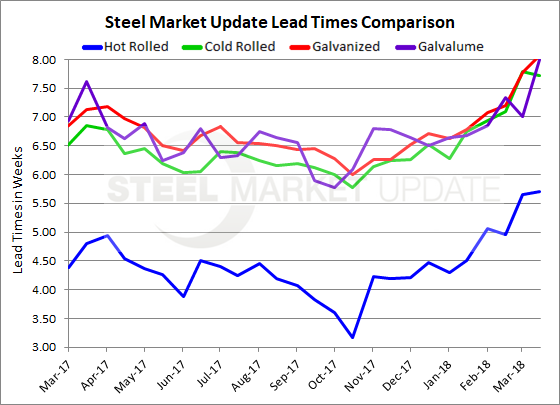SMU Data and Models

Steel Mill Lead Times: Inch Out Further
Written by Tim Triplett
March 22, 2018
Mill lead times on flat rolled steel continue to inch out as supplies tighten and the mills scramble to fill orders. One of the key indicators tracked by Steel Market Update, lead times reflect the activity at the mills and the order levels they are seeing from their customers. SMU’s latest data indicates that the average lead time for hot rolled has grown to between five and six weeks, while cold rolled, galvanized and Galvalume are at or near eight weeks.
About 19 percent of respondents to this week’s SMU market trends questionnaire reported that lead times are highly extended, down from 30 percent two weeks ago, while an additional 64 percent called them slightly longer than usual. Another 17 percent consider lead times normal for this time period. None consider them shorter.
By product category, hot rolled lead times now average 5.70 weeks, up from 4.95 weeks in mid-February. Hot rolled lead times have extended by more than two weeks since steel prices began rising in October.
Cold-rolled lead times now average 7.72 weeks, up from 7.09 weeks just a month ago. Cold rolled lead times saw little change in the past two weeks.
Galvanized lead times have now topped eight weeks, at 8.07, from 7.20 weeks one month ago. Like with cold rolled, buyers have not had to wait this long for galvanized orders since mid-2016. The lead time for Galvalume is also at 8.00 weeks.
“Lead times are vague,” said one executive. “I can’t get a response from anyone with the domestic mills,” said another. “Domestic mills are not booking out as far so they can control the selling price,” said a third respondent.
Note: These lead times are based on the average from manufacturers and steel service centers who participated in this week’s SMU market trends analysis. Our lead times do not predict what any individual may get from any specific mill supplier. Look to your mill rep for actual lead times. Our lead times are meant only to identify trends and changes in the marketplace. To see an interactive history of our Steel Mill Lead Times data, visit our website here.

Tim Triplett
Read more from Tim TriplettLatest in SMU Data and Models

SMU’s June at a glance
A look at SMU data for the month of June.

SMU Survey: Buyers’ Sentiment rebounds from multi-year low
Both of SMU’s Steel Buyers’ Sentiment Indices edged higher this week. Current Sentiment rebounded from a near five-year low, while Future Sentiment rose to a two-month high

SMU flat-rolled market survey results now available
SMU’s latest steel buyers market survey results are now available on our website to all premium members.

SMU Survey: Sheet lead times pull back after early-June blip, plate holds
Following the uptick seen two weeks ago, lead times eased this week for all four sheet products tracked by SMU, while plate lead times held steady, according to this week’s market survey.

SMU Survey: Pricing power abruptly shifts to steel buyers
The majority of steel buyers responding to our latest market survey say domestic mills are more willing to talk price on sheet and plate products than they were earlier this month. Sheet negotiation rates rebounded across the board compared to early June, while our plate negotiation rate hit a full 100%.

